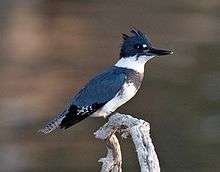Megaceryle
| Megaceryle | |
|---|---|
 | |
| A male belted kingfisher | |
| Scientific classification | |
| Kingdom: | Animalia |
| Phylum: | Chordata |
| Class: | Aves |
| Order: | Coraciiformes |
| Family: | Alcedinidae |
| Subfamily: | Cerylinae |
| Genus: | Megaceryle Kaup, 1848 |
| Species | |
|
M. maxima | |
Megaceryle is a genus of very large kingfishers. Megaceryle is from the Ancient Greek megas, "great", and the existing genus Ceryle.[1]
It comprises four species:
- Giant kingfisher, Megaceryle maxima
- Crested kingfisher, Megaceryle lugubris
- Belted kingfisher, Megaceryle alcyon
- Ringed kingfisher, Megaceryle torquata
All are specialist fish-eaters with prominent stiff crests on their heads. They have dark grey or bluish-grey upperparts, largely unmarked in the two American species, but heavily spotted with white in the Asian crested kingfisher and the African giant kingfisher. The underparts may be white or rufous, and all forms have a contrasting breast band except male ringed kingfisher. The underpart pattern is always different for the two sexes of each species.
These birds nest in horizontal tunnels made in a river bank or sand bank. Both parents excavate the tunnel, incubate the eggs and feed the young.
Megaceryle kingfishers are often seen perched prominently on trees, posts, or other suitable watch-points close to water before plunging in head first after their prey, usually fish, crustaceans or frogs, but sometimes aquatic insects and other suitably sized animals.
Origins and taxonomy
The previous view that the Megaceryle kingfishers arose in the New World from a specialist fish-eating Alcedinid ancestor which crossed the Bering Strait and gave rise to this genus and the American green kingfishers Chloroceryle, with a large crested species later, in the Pliocene, crossing the Atlantic Ocean to give rise to the giant and crested kingfishers [2] is probably wrong. Rather, it now seems that the genus probably originates in the Old World, possibly Africa, and the ancestor of the belted and ringed kingfishers made the ocean crossing [3]
The Megaceryle kingfishers were formerly placed in Ceryle with the pied kingfisher, but the latter is genetically closer to the American green kingfishers.
References
- ↑ Jobling, James A (2010). The Helm Dictionary of Scientific Bird Names. London: Christopher Helm. p. 245. ISBN 978-1-4081-2501-4.
- ↑ C. H. Fry & Kathie Fry; illustrated by Alan Harris (2000). Kingfishers, Bee-eaters and Rollers. Princeton University Press. ISBN 0-691-04879-7.
- ↑ Moyle, Robert G. (2006): "A molecular phylogeny of kingfishers (Alcedinidae) with insights into early biogeographic history". Auk 123(2): 487–499.